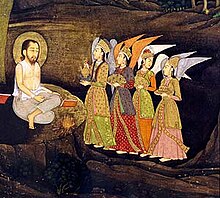Ibrahim ibn Adham (إبراهيم بن أدهم) | |
|---|---|
 A miniature depicting Sultan Ibrahim ibn Adham of Balkh visited by angels, 1760-70. | |
| Mystic | |
| Born | Ibrahim ibn Mansour ibn Zayd ibn Jabir Al-'Ijli c. 718 Balkh |
| Died | c. 782 |
| Venerated in | Islam |
| Major shrine | Mosque of Sultan Ibrahim Ibn Adham, Jableh, Syria |
| Influences | Al-Fuḍayl ibn ʻIyāḍ |
| Influenced | Khwaja Sadid ad-Din Huzaifa al-Marashi, Shaqiq al-Balkhi |
| Part of a series on Islam Sufism |
|---|
 |
|
|

Ibrahim ibn Adham also called Ibrahim Balkhi and Ebrahim-e Adham (Persian: ابراهیم ادهم); c. 718 – c. 782 / AH c. 100 – c. 165[1] is one of the most prominent of the early Sufi saints known for his zuhd (asceticism).
The story of his conversion is one of the most celebrated in Sufi legend, mentioned in the Tazkirat al-Awliya of Attar of Nishapur .[2] Sufi tradition ascribes to Ibrahim countless acts of righteousness and his humble lifestyle, which contrasted sharply with his early life as the king of Balkh (itself an earlier centre of Buddhism). As recounted by Abu Nu'aym al-Isfahani, Ibrahim emphasized the importance of stillness and meditation for asceticism. Rumi extensively described the legend of Ibrahim in his Masnavi. The most famous of Ibrahim's students is Shaqiq al-Balkhi (d. 810).
- ^ Frye, Richard Nelson (1975). The Cambridge History of Iran, Volume 4: The Period from the Arab Invasion to the Saljuqs. Cambridge. p. 450. ISBN 9780521200936.
{{cite book}}: CS1 maint: location missing publisher (link) - ^ "Ibrāhīm b. Adham". The Encyclopaedia of Islam, Second Edition (12 vols.). Leiden: E. J. Brill. 1960–2005.